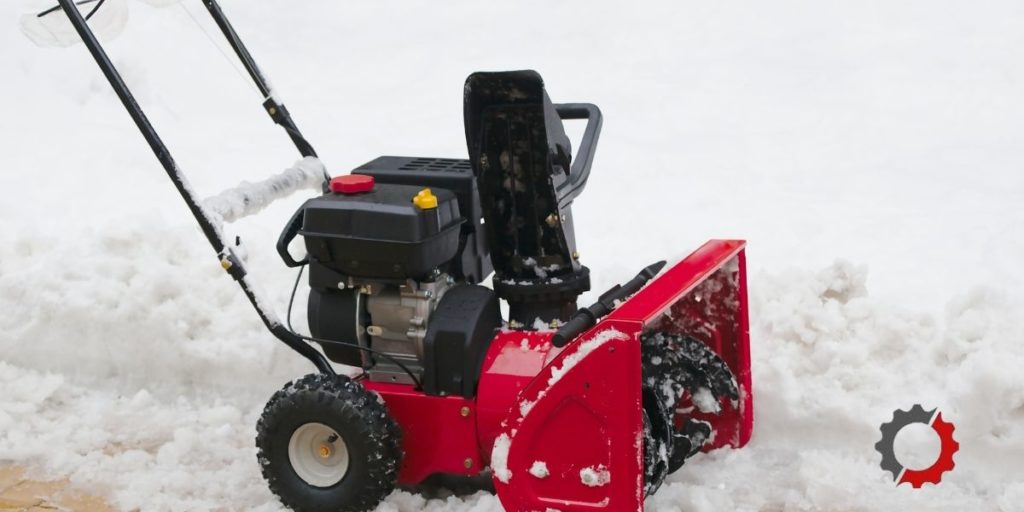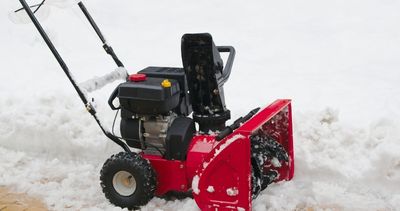Being stuck outside in the middle of a snowstorm isn’t much fun especially when you’re out there with a snow shovel because your snowblower died.
Snow removal becomes a more labor-intensive task when you aren’t able to use your snowblower. You need to get your snowblower back up and running so you can ditch the shovel.
A snowblower keeps stalling when old gas causes fuel restrictions due to a plugged fuel filter, clogged fuel line, bad fuel cap, or dirty carburetor. An incorrect choke setting, bad spark plug or incorrect engine oil level can also cause your snowblower to stall.
Before performing any repairs, turn the snowblower off, remove the ignition key (if your snowblower uses one), disconnect the spark plug wires, and wait for all moving parts to move.
Be careful when working with the auger or impeller as these items are under tension and can cause injury even with the engine off.
Reasons a snowblower stalls:
- Old gas
- Incorrect choke setting
- Plugged fuel filter
- Clogged fuel line
- Dirty carburetor
- Bad spark plug
- Too much engine oil
- Bad fuel cap

This post may include affiliate links. Purchases made through these links may provide a commission for us, at no extra cost to you. As an Amazon Associate, we earn from qualifying purchases.
Follow all safety instructions provided in your equipment operator’s manual prior to diagnosing, repairing, or operating.Consult a professional if you don’t have the skills, or knowledge or are not in the condition to perform the repair safely.
8 Reasons a Snowblower Keeps Stalling
Old Gas Causes a Snowblower to Stall
Gasoline that has been stored in your snowblower or on a shelf before it’s added to your snowblower can cause your snowblower to stall. Gasoline begins to break down 30 days after purchase and becomes less effective.
Ethanol, an alternative fuel used in gasoline to make it more environmentally friendly, is harmful to the small engine used on your snowblower. Ethanol attracts moisture to the fuel.
This water and ethanol mixture will leave behind gummy deposits and corrode fuel system components resulting in fuel restrictions and a lack of fuel for the engine. This will cause your snowblower to keep dying.
Because of the bad effects of ethanol, never use gasoline with high ethanol content. Use unleaded gasoline with a minimum octane rating of 87 and a maximum ethanol content of 10%.
The lower ethanol content or an ethanol-free fuel is best.
Gas for 2-cycle and 4-cycle snowblower engines
- 2-cycle engines have a single fill port for a gas and oil mix. You can find the correct gas and oil ratio for your engine listed on the original fuel cap or in your operator’s manual. The most common gas-to-oil ratios are 50:1, 40:1, and 32:1. Mix gas with a premium 2-cycle oil that is ISO-L-EGD and JASO M345 FD certified
- 4-cycle engines have separate fill ports for gas and oil, one fill port for gas, and one for oil. It uses straight gasoline in the fuel port.
Remove old fuel from your snowblower using a fuel siphon pump. Fill with fresh fuel and a fuel additive like Sea Foam Motor Treatment to reduce moisture, clean the fuel system and stabilize the fuel.
Incorrect Choke Setting Causes a Snowblower to Stall
The choke is used to start a cold engine. When the choke is on, it restricts the amount of air so the cylinder receives a higher concentration of fuel to air than required when the engine is warm.
The engine will stall after it starts when the choke is not adjusted to the off position so the engine gets sufficient air to keep running.
Plugged Fuel Filter Causes a Snowblower to Stall
A fuel filter is used to strain the fuel that comes out of the fuel tank to keep dirt and debris from getting into the fuel system. Dirt and debris can cause fuel restrictions and damage to the engine.
When a fuel filter does not get changed out regularly, it can become plugged which prevents fuel from flowing through the filter.
Replace a plugged fuel filter. Make sure the new filter is installed correctly with the arrow on the side of the filter housing pointed in the direction of the fuel flow.
Clogged Fuel Line Causes a Snowblower to Stall
The fuel line on the snowblower can become clogged with gummy deposits left behind by old fuel. When this happens, there is a lack of sufficient fuel flow causing the engine to run sluggishly and stall.
Use your fuel shut-off valve to stop the flow while you remove an end of the fuel line and place it in a container to collect fuel.
Turn your fuel supply back on and check the container to see if you are getting a good flow of fuel out of the line. If you are, turn off your fuel supply and reattach the fuel line. If you are not, with your fuel supply turned off, remove the section of the fuel line from your snowblower.
Spray carburetor cleaner into the line. What you are trying to do is loosen the clog. Follow this by blowing compressed air through the line to remove the clog. Repeat as necessary until the restriction is removed.
If you are unable to remove the clog or you find the fuel line is dry and cracked, replace it with a new fuel line of the same length and diameter. Install the cleaned line or new replacement fuel line.
Dirty Carburetor Causes a Snowblower to Stall
A dirty snowblower carburetor can be the cause of your snowblower not running. The carburetor is designed to regulate the amount of gas mixed with air to create a combustion.
You will need to check and clean your carburetor if necessary. This may sound complicated, but it really is not.
If you are not very mechanically inclined, you should bring your snowblower to a repair center. If you are mechanically inclined, then read on.
You may need to replace your carburetor if it is in a condition that is beyond cleaning to make work.
12 Steps to Clean Your Dirty Snowblower Carburetor
- Spray carb cleaner to minimize carbon buildup. Spray some carb cleaner in the air intake. Start the engine to see if it will run. If the snowblower fires up and still won’t stay running, then we need to get inside the carburetor.
- Gather pliers, screwdrivers, sockets, and ratchets so you don’t destroy parts while taking the carburetor apart.
- Take a photo for reassembly. These days most people have a handy camera on their phones. It’s a very good idea to take a picture of the carburetor so you can refer to it if you don’t remember how to reassemble it after tearing it apart. You will want to make sure you get a photo showing how the linkage and springs go back on the carburetor.
- Remove the throttle cable and choke cable if your snowblower has one.
- Undo the filter housing and nuts or screws that hold the carburetor.
- Slowly remove the springs so you don’t stretch them out too much. You may have to twist the carb a bit to get the springs off. Also, watch the gasket at this point so you don’t tear it. This is the gasket located between the engine block and the carburetor.
- Remove the bottom screw from the float bowl. The float bowl is where gasoline is stored inside the carburetor. It should have gas in it so have a rag ready to catch the gas.
- Remove the bowl being careful to not damage the o-ring around it. Caution: Do not get any carb cleaner or any other chemical on the o-ring. It will stretch out and you won’t be able to reuse it.
- Inspect the stem for clogged holes. This stem hangs down from the center of the carburetor and has holes in it. If these holes get plugged from old fuel it will not draw fuel up to the jet. If the holds are plugged, take a thick wire to clean them out. It’s easier to see what you’re doing if you use a flashlight. Once you get the holes clean you can rinse them with carb cleaner.
- Inspect the carburetor for hard crusty white buildup. This white buildup is fuel additives including ethanol. You need to try to get as much of the white power material out as you can. It’s nearly impossible to get it all out.
- Reassemble the carburetor now that the carb is clean. Put it back together in the reverse order you took it apart. Remember to refer to the photo you took of the carburetor when reassembling so all parts are reinstalled in the right places.
- Add new fuel that contains and fuel stabilizer before you start your snowblower. Pour the fuel into the tank and give it a chance to fill the bowl of the carburetor. Start your engine. If you are starting with a pull cord, give the rope a yank. It may not start on the first pull, but it should start after several pulls and continue to run.
Bad Spark Plug Causes a Snowblower to Stall
A fouled spark plug will cause intermittent spark issues that can cause the snowblower to quit. Remove the spark plug and check to see if it is dirty and covered in carbon buildup, oil, and dirt.
Clean a dirty spark plug with a wire brush. However, if the plug is very dark in color or damaged, you need to replace it with a new spark plug.
Before reinstalling the clean spark plug or a new spark plug, check the gap is to the manufacturer’s specification. Make necessary adjustments and install the spark plug. Attach the spark plug wire securely.
Too Much Engine Oil Causes a Snowblower to Stall
Running a 4-stage (4-cycle) snowblower with too much oil in the crankcase can cause oil to get up to the spark plug and foul out the plug. This will inhibit the spark needed to run the snowblower.
Read more about the effects of using too much oil in your snowblower in “Too Much Oil in Your Snowblower Can Cause Engine Damage“.
Correct the engine oil level by draining a little oil from your 4-stage engine. Check your spark plug and replace it if it is dirty or covered in oil.
Bad Gas Cap Causes a Snowblower to Stall
The gas cap on the snowblower is designed with a vent to allow air to pass through the cap. When the vent is plugged, the fuel tank forms a vacuum. It won’t allow fuel to leave the fuel tank and your snowblower will die.
To identify a bad gas cap, remove the cap and start the snowblower. If it starts and runs well, reinstall the gas cap and continue to allow the snowblower to run for a while.
Listen for the engine to start running sluggish and then shut down due to a lack of fuel.
If it doesn’t start until you remove the gas cap to allow air to flow into the fuel tank, you most likely have a bad cap. You should replace the bad cap with a new one.
